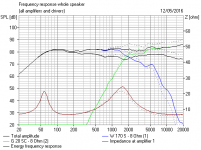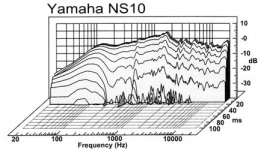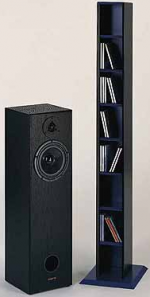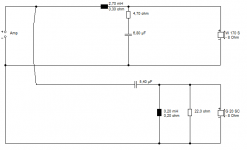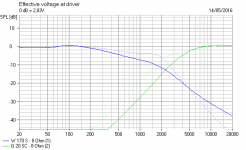The measurements of Yamaha NS10M from Toole's "Sound Reproduction"
reveal that this speaker was designed particularly to have a flat POWER
response, which is very wrong when one puts it in open space, but there is a
rumor on the internet that the guiding idea of making such a speaker was to
counteract the fact (?) that the average loudspeaker set in a home environment
had its bass and HF region lifted up well above the midrange (loudness), so to
put things back in order, they figured the midrange should be pronounced enough
so it sounds normal again.
reveal that this speaker was designed particularly to have a flat POWER
response, which is very wrong when one puts it in open space, but there is a
rumor on the internet that the guiding idea of making such a speaker was to
counteract the fact (?) that the average loudspeaker set in a home environment
had its bass and HF region lifted up well above the midrange (loudness), so to
put things back in order, they figured the midrange should be pronounced enough
so it sounds normal again.
My advice would be to sell the NS10M as they are sort after for studio use. Would be a shame to take another pair out of circulation as they are now rare.
You get better bang for buck building a new speaker from an established design or design your own if you are capable.
I sold a pair of NS10M's in 2003 and fetched a price 3x what I paid in 1978. This allowed me to design and build 2 speakers, a floorstander loudspeaker and a bookshelf loudspeaker which was more suitable for home use.
You get better bang for buck building a new speaker from an established design or design your own if you are capable.
I sold a pair of NS10M's in 2003 and fetched a price 3x what I paid in 1978. This allowed me to design and build 2 speakers, a floorstander loudspeaker and a bookshelf loudspeaker which was more suitable for home use.
The NS10 was originally designed as a consumer bookshelf model so its alignment was allowing for being put almost flush in a bookcase. No step comp or very mild. Being closed box it also had little group delay in the bass. It had a turned paper cone with a glue shim that made it good on resonances. It was sensitive for its size too. Just because fast, one could nail the bass drum and bass guitar mix easier and also because mid forward and clean, one could hear all sorts of things sticking out badly or be aware of those missing in the mids where many instruments and the vocals compete. Not a balanced loudspeaker but one that could make you work more for a mix to sound good. If it sounded good on it it was most usually translating well on anything else. That is why they used it everywhere for decades.
Now we can get rid of the Kleenex.
The naked NS10M was toned down a bit by Yamaha anyway as the original consumer NS10 was meant to be listened with grilles on hence the Kleenex trick because the mix artists removed the grilles for it to look pro-cool with its unusual white cone when perched on the mixer bridge
Thanks for doing that System7. How do you happen to have the FRD files for
these drivers already? Looks like all it needed was some padding for level
balance between bass and tweet. Now we can get rid of the Kleenex.
Hi,
No. He's still posting sims based on the wrong drivers.
Seems to think its OK to be not too far off. It is not.
rgds, sreten.
Last edited:
Thanks for your thoughts, I'm going to make the larger box like
the NS10T ,I have the XO to try. I have plenty of plywood .....
Hi,
Just sell them for a silly expensive price and start
again. That is by far your best option. They are
crap for real hifi TBH and nothing you can do will
make them much better, just ruin their value.
rgds, sreten.
FWIW the myth surrounding the NS10's is they replicated
the faults of many cheap speakers, and any mix that sounded
decent on them would sound good on myriad cheap equipment.
Nothing is ever so simple, but the fact is, the NS10's are legends.
It could so easily have been the AR18S, marketed correctly.
Last edited:
There are at least 3 iterations of the "NS-10" that I have heard, probably 5 or 6 made. As stated the first generation was intended for the consumer market. The NS-10M was the first version intended for studio use, and the NS-10M STUDIO was a later version with a "refined" or "new" tweeter depending on what you read. I got my NS-10M STUDIO's in the late 90's at Sam Ash Music, because they were scheduled for extinction as Yamaha, and many others were moving toward active monitors.
I went into Sam Ash with several CD's of percussive music that I had recorded myself and tried every monitor in their recording room, and the rooms at ACE Music, Guitar Center and Mars Music. The Yamahas flat nailed percussive drums, which none of the others did. They are still sitting on either side of my studio desk. Want better bass? Get a SUB, cross it at about 100Hz. I feed the sub from the same line outs from my audio interface that feeds my amps.
Part of the reason for the great "fast" percussion is the sealed box, which the woofer was designed for. Yes, that kills the response below 80Hz. Any attempt to put that woofer in a ported box will sound terrible.....How do I know this? Yamaha tried it, and it sucked, big time. It was aimed at the home theater market, but was the worst of both worlds. Loose flabby bass....ugly. There was a NS-10 PRO, but I never saw one.
Don't like the NS-10's, as already stated they are still a classic, and in demand....sell them.
I went into Sam Ash with several CD's of percussive music that I had recorded myself and tried every monitor in their recording room, and the rooms at ACE Music, Guitar Center and Mars Music. The Yamahas flat nailed percussive drums, which none of the others did. They are still sitting on either side of my studio desk. Want better bass? Get a SUB, cross it at about 100Hz. I feed the sub from the same line outs from my audio interface that feeds my amps.
Part of the reason for the great "fast" percussion is the sealed box, which the woofer was designed for. Yes, that kills the response below 80Hz. Any attempt to put that woofer in a ported box will sound terrible.....How do I know this? Yamaha tried it, and it sucked, big time. It was aimed at the home theater market, but was the worst of both worlds. Loose flabby bass....ugly. There was a NS-10 PRO, but I never saw one.
Don't like the NS-10's, as already stated they are still a classic, and in demand....sell them.
I found this 8 year old article explaining a lot more about the NS-10's than I ever knew.
The Yamaha NS10 Story
The Yamaha NS10 Story
Thanks for doing that System7. How do you happen to have the FRD files for these drivers already? Looks like all it needed was some padding for level balance between bass and tweet. Now we can get rid of the Kleenex.
You don't really need to know anything about the drivers to know how filters work.
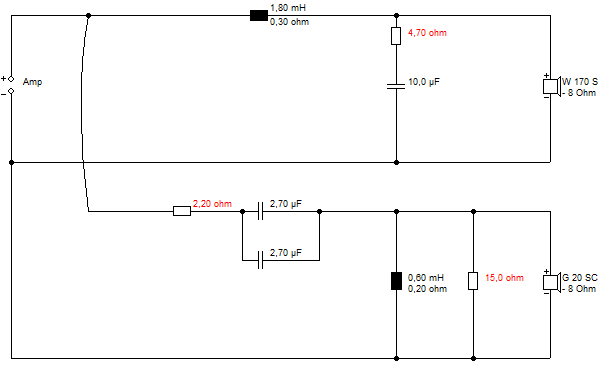
Adding shunt resistance to the bass circuit makes the midrange less peaky and shallower. And 2.2R series and 15R shunt on a tweeter is just 4dB attenuation, however you lay it out. I prefer my way for the higher impedance. Phase alignment actually improves. On second thoughts, smaller 7W resistors would be more than adequate.
Regular 6" paper drivers are 6" paper drivers IMO. Perhaps except for some exotic low inductance Scanspeak and SB designs, they can be treated the same. The shunt 4.7R resistance counteracts the ca. 0.9mH voicecoil inductance. Always an issue with the 5kHz peak too which is a cone resonance, but in practise you notch it at slightly higher at 6kHz if necessary. Just how it works.
Interestingly, Troels Gravesen has done some 6" projects with otherwise identical low inductance SB Acoustics SB17 Polycones, Paper Cones and Metal Cones. The polycone is easiest.
DIY-Loudspeakers
Attachments
Bit of a rant there, sreten. And exceeding the boundaries of forum politeness IMO. You got a better idea? I think we said that placing them close to the wall will increase the apparent bass. And you don't need to know much about the drivers for that effect to work.Hi,
I have a set of Yamaha NS10 speakers and wanted to build something with more bass using these drivers and crossover.Has anyone got any ideas if this can be done.Any help would be great.
thanks
I also stand by my suggestion of lowering the mid and tweeter level, which increases subjective bass. Tuning by ear really can work if you know the tricks. I don't suppose that woofer defies the laws of physics. It's probably 8 ohms and Le 1mH voicecoil inductance. So the electrical response is fairly predictable.
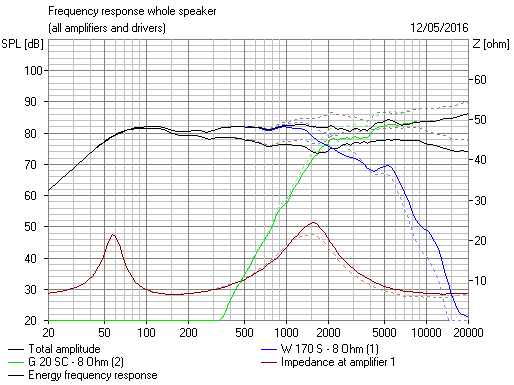
For a £5 worth of 7W wirewound resistors and a bit of soldering, what have you got to lose? It's fun. And if you don't like it, you can put them back as they were.
Last edited:
Now we can get rid of the Kleenex.
I think the preferred tweeter "filter" was Kimwipes.
You don't really need to
know anything about the drivers to know how filters work.
That is absolutely plain wrong. Filter transfer function is calculated
not just based on filter parts values but also on impedance of the load.
If that alone would have been sufficient as you already said, you wouldn't
post response plots of a whole system, including acoustic output
of the drivers.
To call Sreten impolite is so over the line that it's scandalous which
doesn't surprise me.
Agree that you should sell them. Disagree that they make good nearfield monitors, especially in the horizontal orientation usually seen. Yuck!
Arguments for why you should use weird sounding monitors for mixing are beyond me. As others have said, they weren't even designed for on-axis response / nearfield use. That said they are still in demand, because of the strong visual association with "professional studio".
They certainly were an asset to have in my studio photos, though I did 99% of listening on Tannoys...
Arguments for why you should use weird sounding monitors for mixing are beyond me. As others have said, they weren't even designed for on-axis response / nearfield use. That said they are still in demand, because of the strong visual association with "professional studio".
They certainly were an asset to have in my studio photos, though I did 99% of listening on Tannoys...
There is 2 potential tweaks to improve bass extension response.
1. Modify the XO filter to get rid of the wide midrange hump
and pad the tweeter down somewhat
2. Make a vented box out of it.
O.M.G, what a piece of crap!
Have no mercy, sell them to an audio horror collector!
Attachments
Last edited:
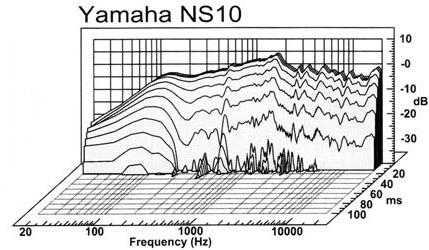
It's not actually as bad as it looks. The power response around the room is quite flat. That 2kHz peak in frequency response occurs at the point where dispersion is weakening, so has some strengths. Probably a good "Rock" speaker with lively guitar harmonics that sounds good all around the room.
Personally I don't like a 2kHz crossover to a tweeter. It's pushing it quite hard and maybe into distortion when loud.
The bigger box and some sort of reflex might work. I really don't know how that will turn out, but it's been done before with 6" bass.
But the more radical option is to increase the bafflestep. Changing to 2.7mH and 6.8R shunt along with a 4.7R resistor lowers the peaky midrange by a huge 6dB. I thought that 0.6mH tweeter coil was way too big also. OK, a complete rebuild, and TBH it might lose everything that was special about it. Who knows 'til you try it. But this IS a DIY forum, and that's the hobby that we so enjoy.
Attachments
Well, it's been three years, so I figure it's time to resurrect a thread...
I just purchased the originals- the NS-10T, which is the "home version"; the "original" speaker re-purposed for studio use. I sort of wanted the original versions to see (perhaps) why they ended up becoming the 10M that is so coveted(??) these days.
I got them for short money (matched pair from the son of the original purchaser) and after removing the thick, sticky, black goo from the sides with isoporpyl alcohol (that was fun! Simple green wasn't up to the challenge!), they look OK. Drivers are in good shape (haven't fired them up yet). A few nicks and dents too, but I may re-make the boxes (same interior volume but more bracing and real veneer)
Most of the data out on the web references the "M" version, the smaller box adaptation (capitalization?) of the NS-10T as a "studio monitor". Interesting that Yamaha defined the market now known as "studio monitor" as it didn't exist prior to speak of. (Horrortones anyone?)
So, based on age, I figured a crossover rebuild was in order. Being an ignoramus on crossover design, I'd probably do what I've done in the past- replace caps with higher quality audiophile caps. But ,maybe there's more to it? More to be had while I'm in there messing stuff up?
Unlike the NS-10M's, the NS-10T's are not commanding the big bucks (so no loss to mod them, other than weirdos like me looking for the REAL NS-10. Must be the "gray" woofers rather than the slick white ones that devalue them, or perhaps the genuine simulated wood tone vinyl wrap... Who knows. I think the larger box is a good thing, as is having "the original" version that was re-purposed, rather than Yamaha re-designing something that really didn't need redesigning.
Now I know the M has a different crossover, different drivers, and a smaller box. But, what were they addressing with so many changes? To make them sound worse? Anyone have any insight or ideas?
So, I'm planning to use these as intended- as bookshelf speakers with a vintage (probably Kenwood- not purchased yet- let me know if you want to unload something) system for my office.
So does anyone have the T version crossover and driver specs to potentially tweak them to a slightly flatter response? If they even need it? I presume the drivers are quite close to the M version (despite the color) and the larger box might be a good thing too. Also sealed- no ports.
Just fishing I guess. Ranting is perhaps a better term. I'm intrigued by these little speakers.
I just purchased the originals- the NS-10T, which is the "home version"; the "original" speaker re-purposed for studio use. I sort of wanted the original versions to see (perhaps) why they ended up becoming the 10M that is so coveted(??) these days.
I got them for short money (matched pair from the son of the original purchaser) and after removing the thick, sticky, black goo from the sides with isoporpyl alcohol (that was fun! Simple green wasn't up to the challenge!), they look OK. Drivers are in good shape (haven't fired them up yet). A few nicks and dents too, but I may re-make the boxes (same interior volume but more bracing and real veneer)
Most of the data out on the web references the "M" version, the smaller box adaptation (capitalization?) of the NS-10T as a "studio monitor". Interesting that Yamaha defined the market now known as "studio monitor" as it didn't exist prior to speak of. (Horrortones anyone?)
So, based on age, I figured a crossover rebuild was in order. Being an ignoramus on crossover design, I'd probably do what I've done in the past- replace caps with higher quality audiophile caps. But ,maybe there's more to it? More to be had while I'm in there messing stuff up?
Unlike the NS-10M's, the NS-10T's are not commanding the big bucks (so no loss to mod them, other than weirdos like me looking for the REAL NS-10. Must be the "gray" woofers rather than the slick white ones that devalue them, or perhaps the genuine simulated wood tone vinyl wrap... Who knows. I think the larger box is a good thing, as is having "the original" version that was re-purposed, rather than Yamaha re-designing something that really didn't need redesigning.
Now I know the M has a different crossover, different drivers, and a smaller box. But, what were they addressing with so many changes? To make them sound worse? Anyone have any insight or ideas?
So, I'm planning to use these as intended- as bookshelf speakers with a vintage (probably Kenwood- not purchased yet- let me know if you want to unload something) system for my office.
So does anyone have the T version crossover and driver specs to potentially tweak them to a slightly flatter response? If they even need it? I presume the drivers are quite close to the M version (despite the color) and the larger box might be a good thing too. Also sealed- no ports.
Just fishing I guess. Ranting is perhaps a better term. I'm intrigued by these little speakers.
- Status
- This old topic is closed. If you want to reopen this topic, contact a moderator using the "Report Post" button.
- Home
- Loudspeakers
- Multi-Way
- yamaha ns10
